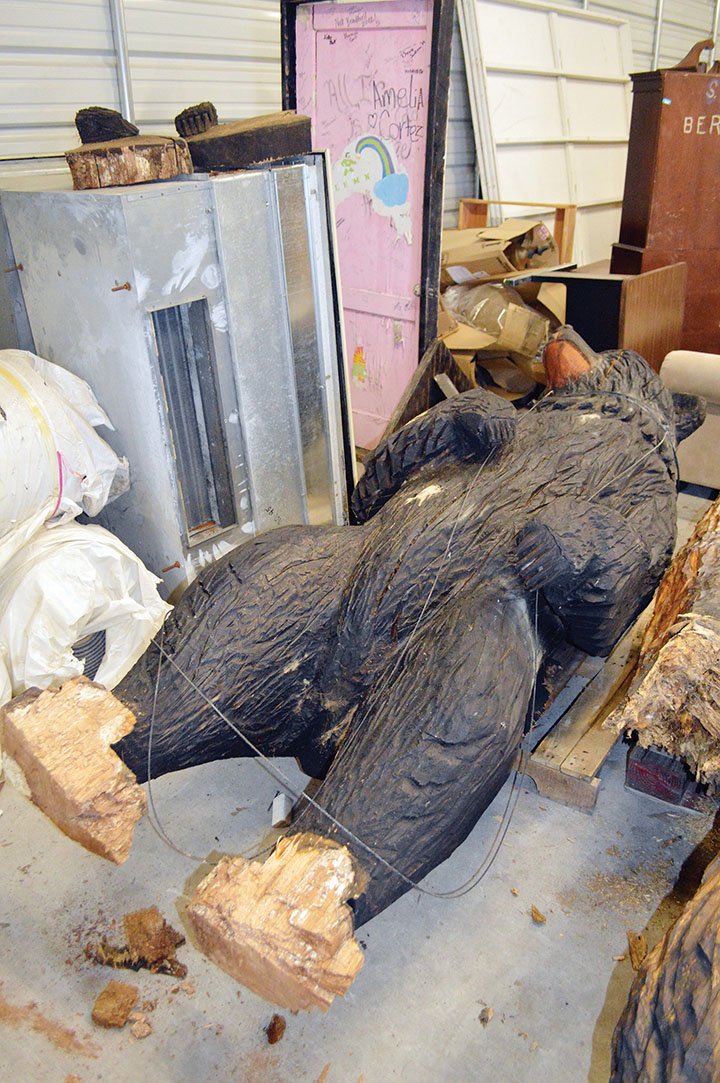The University of Central Arkansas’ wooden bear statue, Valor, has been absent this school year because he has a bug.
Several, actually.
Termites have invaded his feet, and he has been in storage this summer, said Larry Lawrence, director of the UCA Physical Plant.
Lawrence said a structural engineer with Crafton-Tull has been consulted about the best way to repair the bear.
“We did treat him for termites, but we still did have some termites, and we had some water damage and rot,” Lawrence said. “We sealed it many, many times with what the artist told us to use.”
Iowa chainsaw artist Gary Keenan created the 10-foot black bear in May 2013. He used one of the 41 trees planted in 1946 as a living memorial to UCA’s alumni killed in World War II. A tree that that was ailing was used for the sculpture. Lawrence said a few dead limbs had been taken out of the canopy, and he knew it would have to come down at some point.
Valor was carved in front of Wingo Hall, which is the administration building, and is part of the Living Tree Memorial.
“Originally, it was done with the tree in the ground,” Lawrence said. “Over time, we wanted it more permanent, so we put a concrete base in the ground.” Keenan estimated the bear weighs 3,000 to 4,000 pounds.
Lawrence said physical-plant employees noticed a few months ago that Valor was having problems.
“We took him down, because the lower portion — 3 or 4 inches below the knee — was the area we were concerned about,” Lawrence said.
Lawrence said the structural engineer will come up with a final design to repair the bear, but options have been discussed.
“We’re going to keep the same base, but we’re going to design steel legs that go up into the bear. We have cut off pretty much the wood that’s damaged,” Lawrence said.
After the steel is inserted, “we may try to design some product or substance, wood or plaster, that may go around these steel legs so we can do an equivalent of what an artist might do so it will look more like legs. We have discussed — and we don’t know what final product will be — about a plate that would go on his back and cables or rods that will go into the concrete base, the rebar,” Lawrence said.
He said the goal is to make Valor “secure and safe.”
“It needs to withstand wind and weight. The goal is not to have to take him down again,” Lawrence said.
Keenan also created a bear-cub chainsaw carving in 2015 in a diseased tree in the backyard of the UCA President’s Home. It consists of three bear cubs and raccoons.
It, too, has some of the same problems as Valor.
“It’s been there awhile, and it fell over because part of the trunk of the base had similar issues, water rot, etc.,” Lawrence said.
The uprooted tree with the cub carvings lies next to Valor in a storage unit.
“We’re probably going to take a chainsaw, and there are two of them together — separate those two — and there’s another by itself — cut it out by itself and make it flat on the back and maybe hang it on the wall. The two we’ll be able to stand up like in the corner on a floor,” Lawrence said.
Tamara Walkingstick, associate professor of forestry with University of Arkansas Division of Agriculture — Arkansas Forest Resources Center, said the deterioration of the carvings doesn’t surprise her.
“If the trees were on their way out, they may have had rot in the root system,” she said. “Cutting off the top doesn’t mean you cut off whatever disease was in the roots. There’s no stopping that. I hate to say it, but it’s the cycle of life; it’s a dead tree.
“If we didn’t have termites and fungus to break that down, the world would be stacked up to the moon with dead things.”
She said termites eat only dead wood, except for a kind of termites not in Arkansas.
“It’s not their fault,” she said of UCA employees. “Even if they cut down a good tree, the same thing would happen; it would slowly degrade.”
She said the changing moisture in the air in this area affects wood, regardless of whether it’s treated and sealed.
“If we lived in, say, Arizona, it wouldn’t happen,” she said.
Kennan said last week that he knew UCA made a concrete base for Valor, but he did not know about the termites and rot.
“I’m not aware any of the other carvings I’ve done having termites. Wood outside will not last forever. Eventually rot happens, but termites is unusual,” Keenan said. “You’re farther south, and that certainly increases the odds.”
The artist, who also created the shepherd wood carving at First United Methodist Church in Conway, said Valor ranks “very high” on his complete list of projects. “I was very pleased, and I thought everything worked out fairly well; I’m just sorry to hear about the termites,” Keenan said.
Lawrence said it could be late September or early October when Valor returns to his post.
“People like to take pictures there; we’re anxious to get him back up,” he said.
Senior writer Tammy Keith can be reached at (501) 327-0370 or tkeith@arkansasonline.com.
